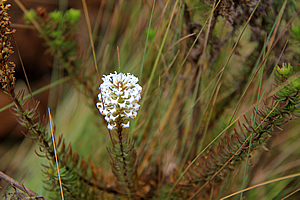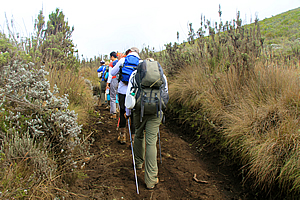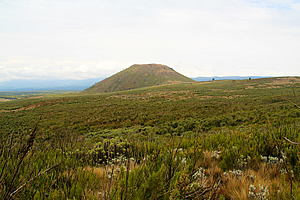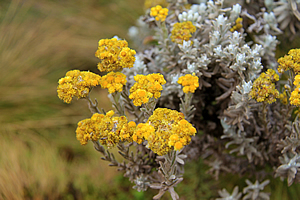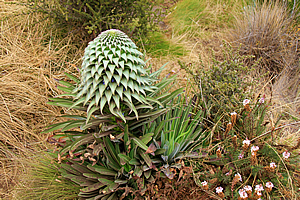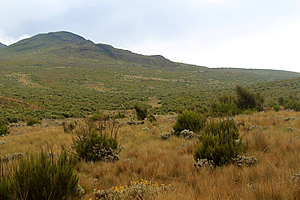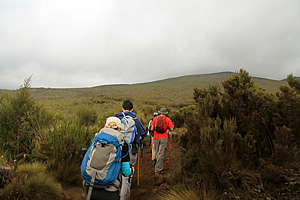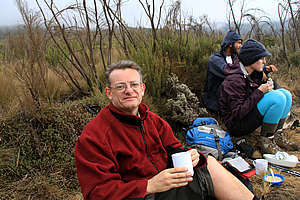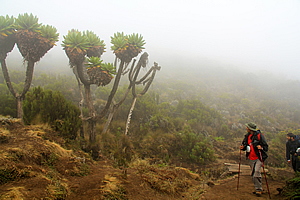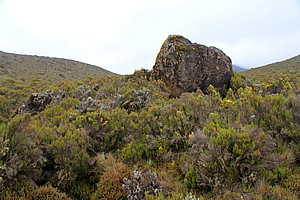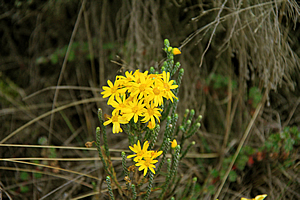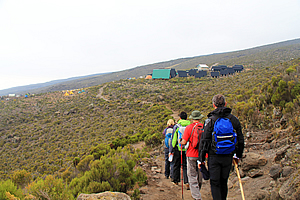--- Archive files ---
Home > Treks > Kilimanjaro > Day 4 > 4.2 |
A Cocoon of thick Fog
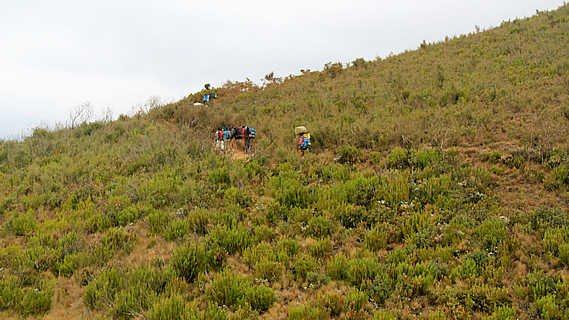
THE HEIGHT of the scrub was now below our heads, giving us for the first time a clear view in all directions. We could just see back to Marangu through the distance. Interesting alpine plants appeared through the yellow tussock. The tussock was endemic to the mountain as would many other species be. We were on a sky island now – an area where the vegetation was isolated from the rest of the world. In this case the forest we had climbed through yesterday between Marangu and Mandara would be isolating these plants from the rest of the world, giving them the opportunity to evolve independently. This was creating species that would be found nowhere else in the world.
Small flower in the heathland |
I had already been to a couple of sky islands. The first was Mount Taranaki, a similar but much steeper volcano under which I was born. There were numerous species growing there that could not be found anywhere else in New Zealand.
That hadn’t even compared to Mount Kinabalu though, with many species of all kinds of plants and even some animals that are not found anywhere else on Earth. Being perhaps the most bio diverse sky island in the world, this one didn’t even compare, but it was still nice to be on a sky island that had its own unique ecosystem.
Climbing the steep dirt path |
The track suddenly steepened and we found ourselves now climbing up soft dried fine soil – very much like peat. It was very soft and dusty – thankfully it hadn’t been raining up here otherwise it would be rather muddy here. For the first time I was glad we were going so slow as it was hard work climbing up the soft peat in the high altitude.
Then I heard the clunking of mattocks. There were a few people ahead who were working the track, improving it for future travellers. It was hard going walking up there over the now uneven surface, but it would have been very hard for them to be digging away at the bank and ground shaping the track.
Solitary volcanic cone |
We plodded past very slowly as tourists began to pass us along with more smelly porters. They were going a lot faster than we were, and the smell of the porters mixed in with the dust we were all kicking up was getting unbearable.
Finally we were atop the small ridge and the track evened up, giving us some much needed respite.
The alpine plants on either side of the track were amazing now. They had very interesting tiny flowers on them. Most plants now were either tussock grasses or they had very small leaves on them, testament to the very harsh cold climate up here. It was very similar to the alpine vegetation I had seen in New Zealand.
Flowers in the heathland |
The soft dusty peat suddenly became thick yellow brown scoria which we crunched through once again. The track was now rather uneven with the rocks protruding through. The large volcanic cone we had passed at the last rest place was now growing distant behind us and we were nearly level with its summit.
We were now starting to wind in and out of the gullies as the terrain here was quite a bit steeper at about twenty degrees. It was still very gentle by mountain standards, but a lot steeper than it had been up till now. Fortunately the track didn’t steepen. Instead it just wound between tiny ridge and gully.
Dendrosenecio Kilimajari |
We rounded the main ridge below the hill above us now a lot closer, and saw the mountain went on and on and on for many kilometres. The cloud was covering the tops now at just a few hundred metres above us. It was hard to imagine what the mountain would look like above. It seemed the hills were all starting to level off as they approached the cloud cover. It wasn’t the classic volcano shape where the gradient increases with altitude. This was evident of erosion of an aged volcano. The summit area hasn’t erupted in around three hundred thousand years, and I guessed it would have been at least a million years since this area has seen activity.
Steepening mountainside |
Upon reaching the top of the ridge we decided to rest for a few minutes. Looking at the view Gary made the comment that this was a huge mountain. It seemed to be bigger than the whole of Banks Peninsula, a cluster of extinct volcanoes, near Christchurch.
There we saw the first specimens of the unusual plant that only grows up here. It was the tallest tree and appeared to be something that came out of a time before the dinosaurs. This was one of the species of giant groundsels – the Dendrosenecio Kilimajari, endemic to this mountain. There were similar species of giant groundsel in other high mountains around equatorial Africa, but this one was unique to here. This small tree has large leaf rosettes where the leaves develop in large buds. They store water in the pith of the stem. This water forms an ice nucleating polysaccharide fluid, a natural form of antifreeze allowing them to survive at these altitudes.
Climbing towards the cloud cover |
We continued walking around the ridge along fairly level terrain under the big hill before it started to steepen again. The temperature was getting noticeably cold. That was to be expected. We were climbing a kilometre per day and one kilometre of altitude equals about six degrees drop in temperature.
Soon the ridge was over and the track became steeper with scoria rock again. The clouds were getting lower. Another layer of cloud had covered the lowlands below us. We were in the region between the low cloud and the mid-level cloud.
Resting just below the cloud |
In the distance at the top of the gentle ridge section we saw a leaning long drop toilet on the side of the track. We walked to just past the toilet and sat down for a lunch break. We pulled out our lunch boxes and ate. Once again my green orange was very sour, and I couldn’t eat it. Everything else got devoured though. Thankfully I still had my appetite. Loss of appetite is meant to be a major symptom of altitude sickness.
The porters gave us a mug each and poured hot tea into the cups. I was over three thousand five hundred metres above sea level now. According to my rule of drinking tea, I had three sugars. It was very sweet, but gave me the energy boost I needed.
Dendrosenecio Kilimajari |
We were finishing lunch when cold drizzle started falling from the dark cloud. We quickly put on our raincoats, shouldered our bags and continued walking.
Within five minutes we saw cloud over the track just ahead of us, and a minute later we were immersed in the cocoon of the grey fog of the mid-level alto nimbus clouds. The mist silently billowed through the small gullies. We were now crossing small bridges over each gully indicating water runs down here during flooding
Rock outcrop |
We hadn’t seen any natural running water since the middle of the forest far below us. I recalled from the volcanoes I had climbed in New Zealand the rock on these mountains was very porous, so the water would just seep into the rock and come out in springs near the bottom of the mountain. The volcanoes of the North Island are very young though. This mountain hasn’t had a significant eruption in over three hundred thousand years. Was that long enough to start plugging in all the leakages?
Then we reached a deeper than normal gully which did have a stream of running water running through it. The vegetation on either side of the gully was very interesting, all sorts of small leaf alpine plant. The large strange dendrosenecio kilimanjari was very abundant in the valleys now.
Flowers on the heathland |
We crossed over another low spur and entered another gully with running water. The cloud started lifting, removing the translucent greyness. The rain stopped falling. The cloud completely lifted, and I looked back. The large crater that had seemed huge at our first resting place was just a tiny truncated cone in the far distance.
We stopped for another rest. There were a lot of interesting primitive mosses in the undergrowth around here. The tussock was a lot lower and thinner, and there were still a lot of bright white and yellow flowers from different alpine plants.
Approaching Horombo Huts |
We got up just as another group reached us, so we were mixed in with them for a while as we crossed a large bridge over a big escarpment bigger than the other gullies we had crossed so far.
We continued for another fifteen minutes before we reached the top of a rather steep bluff and saw a group of huts and tents up the next spur. This was Horombo – our goal for the day. The huts were all A-framed and coloured black. We descended fairly steeply into the next gully then back up the other side rather steeply up the gravely scoria.
<< Previous | Next >> |
|
||
About this Page
|
||
|
|
|
Where is Walkabout Jeff? |
|
|
|
|
What is happening in Walkabout Jeff's hometown?
|
|
|
|
|
Who is Walkabout Jeff?Any normal person's idea of going out involves going to the local pub for a drink with a few mates. Walkabout Jeff isn't normal.
|
|
|
|
|
